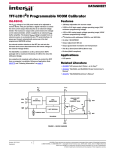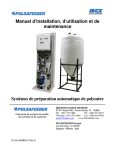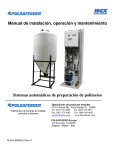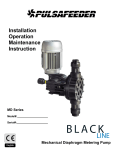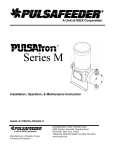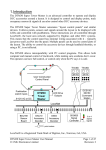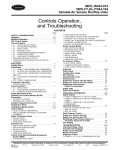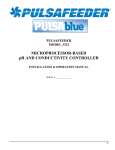Download Pulsafeeder DC3 Troubleshooting guide
Transcript
Installation Operation Maintenance ADDENDUM Bulletin #: PS-IOM-HYPO2-0111-A FACTORY SERVICE POLICY If you are experiencing a problem with your Pulsafeeder pump, first review the IOM, and consult the troubleshooting guide. If the problem is not covered or cannot be solved, please contact your local PULSA Series Sales Representative or our Technical Service Department at (585) 292-8000 for further assistance. Trained individuals are available to diagnose your problem and arrange a solution. Solutions may include purchasing a replacement unit or returning the pump or components to the factory for inspection and repair. All returns require a Return Material Authorization (R.M.A.) number to be issued by Pulsafeeder. Certain components may be purchased for replacement. Parts purchased to correct a warranty issue may be credited after examination of the original parts by Pulsafeeder personnel. Parts returned for warranty consideration that test satisfactorily, will be sent back to the originator freight collect. Any field modifications will void the Pulsafeeder warranty. Out-of-warranty repairs will be subject to Pulsafeeder's standard bench fees and testing costs associated with replacement components. Notice Information and specifications in this document are subject to change without notice. Revision History: Rev A (01-01-11) - Original Release Date Copyright Copyright © 2003 Pulsafeeder, Inc. All rights reserved. Information in this document is subject to change without notice. No part of this publication may be reproduced, stored in a retrieval system or transmitted in any form or any means electronic or mechanical, including photocopying and recording for any purpose other than the purchaser’s personal use without the written permission of Pulsafeeder, Inc. Trademarks PULSAR® is a registered trademark of Pulsafeeder, Inc. PULSAR HypoPump® is a registered trademark of Pulsafeeder, Inc. Cruise Control® is a registered trademark of Pulsafeeder, Inc. PULSAR Shadow® is a registered trademark of Pulsafeeder, Inc. ii Table of Contents 1. CONVENTIONS ...................................................................................................................................... IV 2. GENERAL SAFETY ................................................................................................................................ 1 2.1 Explosive Atmosphere Safety ................................................................................................ 1 2.2 Electrical Safety ....................................................................................................................... 1 2.3 Hydraulic Safety ...................................................................................................................... 1 3. EQUIPMENT INSPECTION ....................................................................................................................... 2 4. STORAGE………………………………………………………………………………………………..………2 4.1 Short Term (0 - 12 months) ..................................................................................................... 2 4.2 Long Term (12 months or more) ............................................................................................ 2 5. RETROFIT………………………………………………………………………………………,………………2 6. OVERALL SYSTEM DIAGRAM ................................................................................................................. 3 7. INSTALLATION ...................................................................................................................................... 4 7.1 Location .................................................................................................................................... 4 7.2 Installation Notes..................................................................................................................... 4 7.3 Electrical Wiring ...................................................................................................................... 4 8. DESCRIPTION AND OPERATION .............................................................................................................. 6 8.1 Principle of Operation ............................................................................................................. 6 8.2 General Description ................................................................................................................ 6 8.3 Operation of Manual Override Button .................................................................................. 6 9. MAINTENANCE ...................................................................................................................................... 7 9.1 Maintenance Notes .................................................................................................................. 7 9.2 Auto De-gas Valve Seal Kit Replacement ............................................................................. 7 9.3 Auto De-gas Valve Body and Discharge Valve Assembly Removal………………………11 10. TROUBLESHOOTING GUIDE………………………………………………………………………………..…11 USER NOTE: This addendum serves as additional information for Pulsafeeder PULSAR® and PULSAR Shadow® metering pumps equipped with the Auto De-gas Valve for purging trapped gasses from the reagent head. You must also reference the latest revision of the complete PULSAR® or PULSAR Shadow® pump IOM for critical safety and operational information. iii 1. Conventions For the remainder of this bulletin, the following Conventions are in effect. A WARNING DEFINES A CONDITION THAT COULD CAUSE DAMAGE TO BOTH THE EQUIPMENT AND THE PERSONNEL OPERATING IT. PAY CLOSE ATTENTION TO ANY WARNING. Notes are general information meant to make operating the equipment easier. Tips have been included within this bulletin to help the operator run the equipment in the most efficient manner possible. These “Tips” are drawn from the knowledge and experience of our staff engineers, and input from the field. The HYPO2 Auto De-gas Pump, designed for purging entrained gas from the pump reagent head, is referred to in this manual as the “ADV”. iv 2. General Safety The Auto De-gas Valve (ADV) was designed as a gas handling/priming aid for operation solely with Pulsafeeder PULSAR® and PULSAR Shadow® metering pumps. Use for any other application is considered un-safe and voids all certification markings and warranties. 2.1 Explosive Atmosphere Safety Explosion Hazard -- Do not perform installation or maintenance of any kind on this device while circuit is live and/or the area is known to be hazardous. This unit is not intended for use in explosive or hazardous locations. 2.2 Electrical Safety Improper application and use of the ADV can be hazardous. You are solely responsible for its use. The ADV electrical installation must conform to all relevant electrical codes. Installation and electrical maintenance must be performed by a qualified electrician. Before installing or servicing this device, all power must be disconnected from the source at the main distribution panel. The ADV emits electro-magnetic energy. Its use is restricted to industrial applications. You are responsible for shielding this device if necessary. It is recommended that the ADV be powered from a Ground Fault Circuit Interrupter (GFCI) protected electrical circuit. 2.3 Hydraulic Safety Thoroughly review and adhere to the contents of the latest version of the PULSAR® or PULSAR Shadow® Installation, Operation, Maintenance (IOM) manual for hydraulic installation of your metering pump. 1 3. Equipment Inspection When you receive your order, check all equipment for: Completeness against the shipping document / purchase order Evidence of shipping damage. Shortages or damage should be reported immediately to the carrier and your PULSAFEEDER representative. 4. Storage The ADV can be successfully stored for extended periods. The key to this success is temperature and humidity control. Be certain to follow the additional storage instructions provided in the IOM for the PULSAR® or PULSAR Shadow® pumps, and also those included in the IOM for any controllers (DLC, DLCM, ECA) that are attached to the pump. 4.1 Short Term (0 - 12 months) The ADV should be stored in a temperature and humidity controlled environment. It is preferable to keep the temperature constant in the range of -18 to 60 Celsius (0 to 140 Fahrenheit). The relative humidity should be 0 to 90% non-condensing. If the ADV is installed on the pump, it should not be removed during this period – provided the above conditions can be applied to the pump as well. If the ADV was shipped in its own carton, it should be stored in that carton. 4.2 Long Term (12 months or more) Storage of the ADV for periods of longer than twelve months is not recommended. If extended storage is unavoidable the ADV should be stored in accordance with those conditions stipulated for Short Term Storage. In addition, a porous bag of 85g (3 oz) silica gel or similar desiccant should be placed inside the ADV enclosure. The cover should be re-installed to seal the desiccant within the enclosure. The conduit connection must be tightly capped. 5. Retrofit Retrofit kits including the HypoPump® reagent head assembly, the ADV, and other necessary parts and hardware, are available. These allow the conversion of an existing Pulsafeeder PULSAR® and PULSAR Shadow® metering pumps to a HypoPump®. This conversion can be performed in the field. Port-to-port dimensions and certain other specifications and ratings may change. Consult your local Pulsafeeder sales representative for more information. 2 6. Overall System Diagram \ Figure 1 The ADV consists of a pressure balanced valve which opens periodically to allow fluid from the discharge line to bypass the discharge check valve and flow back into the pump head. The valve is actuated by a solenoid controlled by a solid-state timer. The ADV Valve Assembly incorporates a dual sealing design to insure the valve function even if the Primary Bellows seal fails. The Leak Detection Port (1/8” NPTF) allows visual indication of a Bellows failure while allowing the ADV to keep functioning. At the discretion of the user, this port may be used to pipe any leakage to a safe vessel or a leak detection device. 3 7. Installation 7.1 Location Review the Safety section prior to installing the pump with ADV. It contains information required to properly install and operate the ADV in an industrial environment. Review the PULSAR® or PULSAR Shadow® Installation Operation Maintenance manual provided with your metering pump. It details system related issues that are important to proper operation of the pump and also the ADV. The ADV should be mounted in an area where the operator has access to the front of the unit. Avoid locations where the ADV would be subjected to extreme cold or heat. Note the warning statement on the next page. The installation of this device must comply with national, state and local codes. Allow 6 inches minimum clearance from the front of the ADV enclosure to allow for removal and re-installation of the ADV as a unit. AVOID LOCATIONS WHERE THE ADV WOULD BE SUBJECTED TO EXTREME COLD OR HEAT OR DIRECT SUNLIGHT. FAILURE TO OBSERVE THIS WARNING COULD DAMAGE THE ADV AND VOID ITS WARRANTY MINIMUM OPERATING TEMPERATURE 0 CELSIUS / 32 FAHRENHEIT MAXIMUM (PVC CONSTRUCTION) 49 CELSIUS / 120 FAHRENHEIT MAXIMUM (PVDF CONSTRUCTION) 65 CELSIUS / 150 FAHRENHEIT 7.2 Installation Notes 1. Do not make any electrical connections without adequate grounding. 2. Conduit connections can carry fluids and vapors into the ADV causing damage and voiding the warranty. Care should be taken when installing conduit to protect against fluid/vapor entry. If necessary, provide sealed entries or conduit drains near the point of entry. 3. It is recommended that the ADV be powered from a Ground Fault Circuit Interrupter (GFCI) protected electrical circuit. 7.3 Electrical Wiring The ADV is available in two voltages, and is rated as follows: 115 VAC, 50/60 Hz, 0.2 A OR 230 VAC, 50/60 Hz, 0.1 A The ADV voltage is indicated on the enclosure label. 4 Install wiring to the unit using a minimum of 18 inches of flexible conduit or cable attached to the auto valve assembly in order to facilitate removal of the valve assembly from the reagent head for cleaning or maintenance. Wiring must conform to all applicable codes. Prior to pump startup; always check to ensure that the ADV voltage and frequency matches that of the power supply. It is recommended that the ADV be powered from a Ground Fault Circuit Interrupter (GFCI) protected electrical circuit. 1. Remove the enclosure front cover. Note: The plastic screw hole plugs can be pried out using a flat bladed tool. 2. Bring AC power and ground wires into valve assembly enclosure through the 7/8” diameter hole in the side of the enclosure. Use #18 AWG 105 degree C insulation wire size minimum. Connect per the wiring diagram. The wiring diagram is also reproduced on a label affixed to the back of the enclosure cover. Wiring Diagram 3. Apply power to the valve assembly with or without the pump running. Verify that the solenoid mounted on the pump reagent head clicks every 30 seconds. 4. Reattach cover and replace plastic hole plugs over screws. 2 8. Description and Operation 8.1 Principle of Operation Reciprocating metering pumps are used with a wide variety of chemicals, such as sodium hypochlorite, that produce gas within the piping and pump systems. This gas can accumulate in the pump reagent head, causing the pump to “air bind” and lose prime. The Auto De-gas Valve (ADV) prevents this by allowing a small amount of pressurized fluid from the discharge line to bleed back into the pump head, thereby helping to keep the pump head primed and also displacing gas through the discharge check valve. The system also has a Manual Override Button to enable faster pump priming at pump startup or other situations. 8.2 General Description The PULSAR® and PULSAR Shadow® HypoPump® system consists of the pump reagent head, suction and discharge valves, and Auto De-gas Valve (ADV). The ADV consists of a pressure balanced valve which opens periodically to allow fluid from the discharge line to bypass the discharge check valve and flow back into the pump head. The valve is actuated by a solenoid controlled by a solid-state timer. This pre-set timer will operate properly in the majority of HypoPump applications. Power supply required is 115 or 230 VAC, 50 or 60 hz. All electrical components are enclosed in a NEMA 4X (IP 65) enclosure, which is isolated from the pumped fluid. The timer is preset at the factory to open for 0.25 seconds every 30 seconds in order to achieve optimum gas handling time with minimal pump capacity loss. The valve assembly is easily removed from the pump head in order to access the discharge check valve for cleaning or replacement. The automatic valve assembly can be run independently of the pump motor and/or controls. 8.3 Operation of Manual Override Button The Manual Override Button functions as a fast priming aid. For best results depress the button 1 second every few seconds. Do not hold the button down continuously. Depress the button 1 second every few seconds Figure 4 6 9. Maintenance 9.1 Maintenance Notes The O-ring seals used in the check valve and ADV are critical to product containment and pump operation. All o-rings should be inspected carefully and any that show signs of damage or wear should be replaced. The owner may wish to replace these seals any time the ADV assembly is removed from the pump. A complete cartridge seal assembly is available to the owner as a separate repair part. If necessary, the complete ADV assembly is available as a repair item. 9.2 Auto De-gas Valve Seal Kit Replacement (NP999130-000) CAUTION: Take all precautions to prevent environmental and personnel exposure to hazardous materials. Any product being pumped will be released during this procedure. 1. Disconnect the power source to the pump drive motor and ADV. 2. Relieve all pressure from the piping system and follow safety requirements for contact / exposure to the fluid being pumped. 3. Remove Cap Nut from front of solenoid and slide off solenoid. 4. Loosen and remove the Union Nut. At this point fluid being pumped may be released from the assembly. 5. Remove Core Tube Assembly. 7 6. Remove outer spring from Core Assembly (Seal Kit Assembly) and pull Core Assembly out. 7. Inspect Valve Body for O-rings that may have been left in and remove. Locate and remove both O-rings 8. Remove the sleeve from the Core Tube and remove the O-ring. 9. Locate parts from the Seal Kit. Inspect Seal Kit parts and insure the small spring is in the core. CAUTION: Do not unscrew any part of the seal kit during inspection or reassembly. Any change in length will affect valve performance. 8 10. Install NEW O-ring onto core tube, lubricate with lubricant that is compatible with product being pumped, and reinstall sleeve over Core Tube. 11. Install NEW O-ring on Seal Kit and with lubricant that is compatible with product being pumped. 12. Apply a lubricant that is compatible with product being pumped to the Body O-ring and install into Valve Body. 13. Install NEW Seal Kit into Valve Body. Use care to ONLY push straight into bore. 14. Install New spring over Core and check that Small Spring is still in the Core. Check that small spring is inserted in Core 9 15. Slide Core Tube over core and align to the tabs on the Valve Body. 16. Slide Union Nut over Core Tube and tighten onto Body. Do not over tighten, hand tight is sufficient. 17. Slide the solenoid over the Core Tube and secure with Cap Nut. Hand Tight. 18. Reapply power to the pump and ADV and follow standard startup instructions from IOM supplied with pump. 9.3 Valve Body and Discharge Valve Assembly Removal CAUTION: Take all precautions to prevent environmental and personnel exposure to hazardous materials. Any product being pumped will be released during this procedure. The O-ring seals used in the check valve and ADV are critical to product containment and pump operation. All o-rings should be inspected carefully and any that show signs of damage or wear should be replaced. The owner may wish to replace these seals any time the ADV assembly is removed from the pump. 1. Disconnect the power source to the pump drive motor. If you plan to maintain the ADV itself, remove power from the ADV unit. For maintenance to the check valves only, the ADV need not be disconnected. 2. Relieve all pressure from the piping system. 3. Close the inlet and outlet shutoff valves. 4. Take all precautions to prevent environmental and personnel exposure to hazardous materials. 10 5. Loosen the suction valve tiebar bolts and shift the suction piping slightly to drain any liquid from the reagent head cavity. If the piping is closely connected it may be necessary to disconnect a union or flange. 6. Loosen the tiebar bolts on the discharge valve and shift the piping slightly to drain any liquid. 7. Slide the valve assembly away from the front of the reagent head. Take care to not let the check valve parts fall out of the bottom of the valve assembly as it is removed from the reagent head. 8. Once the ADV is separated, the discharge check valve components can be removed from the assembly and cleaned or replaced. 9. Installation is the reverse of the above procedure. Be sure that the oval shaped o-ring on the bottom of the valve assembly is in the proper position when reinstalling the valve assembly. 10. Troubleshooting Guide Symptom Probable Cause Possible Solution Pump does not prime (product side) Purge relay not operational Verify power is present at timing relay. Valve not actuating Verify power is present at Valve Solenoid and there is a clicking noise every 30 seconds. Check valves fouled or damaged Clean or replace suction and/or discharge check valves as per pump IOM. Power interruption Check that power is connected to the ADV Valve stuck open Clean or replace Seal Kit. Check valves fouled or damaged. Clean or replace suction and/or discharge check valves as per pump IOM. Calibration or testing error Evaluate cause and correct ADV Valve fouled Clean or replace Seal Kit Leak detection port shows leakage Failed Bellows Seal Install New Seal Kit Valve fails to actuate Power interruption Verify power is present at Valve Solenoid and there is a clicking noise every 30 seconds. Crystallized product in valve assembly Clean or replace Seal Kit. Low pump delivery 11 12 PS-IOM-HYPO2-0111-A

















